Pearl Zhu's Blog, page 1274
November 25, 2016
The Popular Quotes Collection II of “Digital Master” Book Series
 “Digital Master” is the series of guidebooks (11+ books) with five pillars to perceive the multifaceted impact digital is making to the business and our society, help forward-thinking organizations navigate through the digital journey in a systematic way, and avoid “rogue digital.” Here is the set of popular quotes for conveying the digital vision and sharing the unique insight about the digital transformation.
“Digital Master” is the series of guidebooks (11+ books) with five pillars to perceive the multifaceted impact digital is making to the business and our society, help forward-thinking organizations navigate through the digital journey in a systematic way, and avoid “rogue digital.” Here is the set of popular quotes for conveying the digital vision and sharing the unique insight about the digital transformation. Digital Master by Pearl Zhu
Digital Master by Pearl ZhuDigital Master Quotes““The sociological organization is alive, holistic, vibrant, energetic, responsive, fluid, creative and innovation.” ― Pearl Zhu, Digital Master: Debunk the Myths of Enterprise Digital Maturity
“An innovative mind allows “the creative flow” to open up for information abundance.” ― Pearl Zhu, Digital Master: Debunk the Myths of Enterprise Digital Maturity
“Strategy is for making progress and progress is in simplicity.” ― Pearl Zhu, Digital Master: Debunk the Myths of Enterprise Digital Maturity
“High mature digital organizations stretch out in every business dimension.” ― Pearl Zhu, Digital Master: Debunk the Myths of Enterprise Digital Maturity
 Thinkingaire: 100 Game-Changing Digital Mindsets to Compete for the Future
Thinkingaire: 100 Game-Changing Digital Mindsets to Compete for the FutureWisdom is the intelligent use of our knowledge, whereas sensibility is an intelligent use of our judgment.” ― Pearl Zhu, Thinkingaire: 100 Game-Changing Digital Mindsets to Compete for the Future
“Clarity is a perception; it’s an emotional alignment of thoughts, intuitions, inclinations, expression and expectations.” ― Pearl Zhu, Thinkingaire: 100 Game-Changing Digital Mindsets to Compete for the Future
“Learning is the way to keep your mind flowing, and hence your life flowing” ― Pearl Zhu, Thinkingaire: 100 Game-Changing Digital Mindsets to Compete for the Future
“A flexible mind has a better chance to think differently and take a unique path in the life journey.” ― Pearl Zhu, Thinkingaire: 100 Game-Changing Digital Mindsets to Compete for the Future
“Open the mind to be on a path to a better version of yourself.” ― Pearl Zhu, Thinkingaire: 100 Game-Changing Digital Mindsets to Compete for the Future
 CIO Master: Unleash the Digital Potential of It b
CIO Master: Unleash the Digital Potential of It bThe pervasive digitalization or IT consumerism requires the balance of the “old experience” and the “new way to do things,” the “learning and doing.” ― Pearl Zhu, CIO Master: Unleash the Digital Potential of It
“The business’s potential depends on how it unleashes its information potential and talent potential.” ― Pearl Zhu, CIO Master: Unleash the Digital Potential of It
“The CIO needs to be an enterprise ‘polyglot,’ to master both business language and IT terminology, and beyond.”
“IT delivery is about People, Process, and Technology.” ― Pearl Zhu, CIO Master: Unleash the Digital Potential of It
“Digital IT is all about speed, agility, and flexibility.” ― Pearl Zhu, CIO Master: Unleash the Digital Potential of It
 Leadership Master: Five Digital Trends to Leap Leadership Maturity
Leadership Master: Five Digital Trends to Leap Leadership Maturity“Authenticity is the most fundamental, but challenging attribute for leadership.” ― Pearl Zhu, Leadership Master: Five Digital Trends to Leap Leadership Maturity
“Innovative leadership is essentially anchored on the leader’s overall multifaceted resourcefulness and multidimensional competencies.” ― Pearl Zhu, Leadership Master: Five Digital Trends to Leap Leadership Maturity
“It seems to be most leaders have more conventional wisdom, but creative leaders have better common sense.” ― Pearl Zhu, Leadership Master: Five Digital Trends to Leap Leadership Maturity
“Digital fit” should be first defined as “mind fit,” and then following with attitude fit and behavior fit.” ― Pearl Zhu, Leadership Master: Five Digital Trends to Leap Leadership Maturity
“The creativity strength is like a spinning wheel, you need to figure out how to boost it up.” ― Pearl Zhu, Leadership Master: Five Digital Trends to Leap Leadership Maturity
 Digitizing Boardroom: The Multifaceted Aspects of Digital Ready Boards by Pearl Zhu
Digitizing Boardroom: The Multifaceted Aspects of Digital Ready Boards by Pearl ZhuDigital leadership must be extremely visionary, mindful, creative, empathetic, generous, conscious, passionate, and humble.” ― Pearl Zhu, Digitizing Boardroom: The Multifaceted Aspects of Digital Ready Boards
“The purpose of Innovation Management is to prepare everything to maximize the transformation of an idea to innovation, through well-prepared processes and structures.” ― Pearl Zhu, Digitizing Boardroom: The Multifaceted Aspects of Digital Ready Boards
“Breaking rules is indeed an important part of creativity. Innovation needs a level of guidance.” ― Pearl Zhu, Digitizing Boardroom: The Multifaceted Aspects of Digital Ready Boards
“An IT friendly Board should change the perspective to understand the power of information and the potential of technology.” ― Pearl Zhu, Digitizing Boardroom: The Multifaceted Aspects of Digital Ready Boards
“Every decision by every decision-maker needs to be informed by an understanding of how technology changes business processes.” ― Pearl Zhu, Digitizing Boardroom: The Multifaceted Aspects of Digital Ready Boards
Follow us at: @Pearl_Zhu
Published on November 25, 2016 22:53
The New Book “Unpuzzling Innovation” Introduction Chapter 3 Digital Innovators
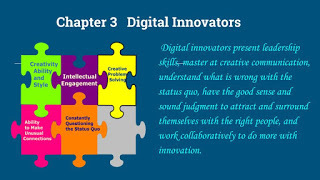 Creativity is the most wanted skill in the digital era due to the increasing speed of changes, fierce competition, and unprecedented uncertainty and ambiguity. But who are digital innovators? Do innovators belong to a rare breed, or are innovators just among us and within us? And what are important personas do digital innovators present?
Creativity is the most wanted skill in the digital era due to the increasing speed of changes, fierce competition, and unprecedented uncertainty and ambiguity. But who are digital innovators? Do innovators belong to a rare breed, or are innovators just among us and within us? And what are important personas do digital innovators present?Creative problem-solving: Creative minds with cognitive differences can reframe questions before answering them, to focus on WHY, before getting to the HOW. Innovators obviously thinking differently - problem-solving is part of their DNA whether it is in the invention, marketing, repurposing something already being there. As far as leading change is concerned, there is a lot of crossover between change leadership and creativity, creative leaders have the ability to reframe the circumstances or conditions around a problem, assimilate all relevant and available information, transform them into business insight, consciously cultivate a culture of innovation, and solve problems creatively,
The people who helped to shape our world are some of the broadest and innovative thinkers: The progress of the world is pushed forward by a select few who were applying broad and diverse skills to create the impossible. As we go through the digital and information revolution, we must embrace the skills of the past to build the new capabilities, and refocus on the problems we are solving and use any number of skills and disciplines to get there. To create the new requires not just one skill, but many, not just old experience, but the new perspective. And more often than not, you can not do on your own, no matter how broad your skills, you still need a diverse team of talent people who help bring all sorts of strengths and capabilities together.
 Cultivating the culture of innovation is more important than training, in order to sow innovation seeds in organizations: The business’ innovation capability depends on its people, the team of talent who can transform the novel ideas to achieve the commercial value. Ultimately, if the company doesn’t have the expectation of innovativeness in its DNA, innovation training is all for naught. Better you create an atmosphere where staffs are encouraged to offer innovative, creative and insightful proposals for new products, new initiatives in cost reductions and better. Engagement by staff is increased when they are aware that there is a way to contribute. The innovation training is also not one size fits all. Innovation methodology, process, and tools can be taught, however, the innovation capabilities cannot be imposed by instruction or example. It is the nature of talent which should be discovered on their own and nurtured through the teamwork. The groundbreaking inventions or innovations are driven by people not only far-sighted but determined to make their ideas succeed.
Cultivating the culture of innovation is more important than training, in order to sow innovation seeds in organizations: The business’ innovation capability depends on its people, the team of talent who can transform the novel ideas to achieve the commercial value. Ultimately, if the company doesn’t have the expectation of innovativeness in its DNA, innovation training is all for naught. Better you create an atmosphere where staffs are encouraged to offer innovative, creative and insightful proposals for new products, new initiatives in cost reductions and better. Engagement by staff is increased when they are aware that there is a way to contribute. The innovation training is also not one size fits all. Innovation methodology, process, and tools can be taught, however, the innovation capabilities cannot be imposed by instruction or example. It is the nature of talent which should be discovered on their own and nurtured through the teamwork. The groundbreaking inventions or innovations are driven by people not only far-sighted but determined to make their ideas succeed. Organizations need to invest in the cultivation of capacity for innovation. Mutual trust, innovation leadership, and emotional maturity are all critical in building a highly effective innovation team and achieve an exceptional result. Follow us at: @Pearl_Zhu
Published on November 25, 2016 22:50
November 24, 2016
Happy Thanksgiving with “MINDFULNESS” via Dot-Connections
Share insight and be mindful to celebrate Thanksgiving holiday season.
 It’s another Thanksgiving Day approaching, it’s not just the time for shopping or relaxing, but also the time to recharging and doing some introspection. It is not just the time to gain a few pounds, but also doing more PONDERING. In the other word, happy Thanksgiving with mindfulness. Although you can’t control every event of your life journey, but via the power of digital mind-crafting, you can adapt to the change and cultivate the new sets of mind. Indeed, mindset is far more important than talent. Talent can always be developed by those with an open and right mindset. In the book of “ Thinkingaire,” we introduce the 100 game-changing digital mind-sets, here we sum up a set of mind with holiday themes: Self-Awareness Mind: Know Thyself -Holiday season is the right time to take a pause and do some self reflection to understanding self better. We are all on the journey to self-awareness; some simply have a greater recognition of being on that road. There are different kinds of leaders and thus different forms of leadership. The one constant is the need to begin by leading oneself.
It’s another Thanksgiving Day approaching, it’s not just the time for shopping or relaxing, but also the time to recharging and doing some introspection. It is not just the time to gain a few pounds, but also doing more PONDERING. In the other word, happy Thanksgiving with mindfulness. Although you can’t control every event of your life journey, but via the power of digital mind-crafting, you can adapt to the change and cultivate the new sets of mind. Indeed, mindset is far more important than talent. Talent can always be developed by those with an open and right mindset. In the book of “ Thinkingaire,” we introduce the 100 game-changing digital mind-sets, here we sum up a set of mind with holiday themes: Self-Awareness Mind: Know Thyself -Holiday season is the right time to take a pause and do some self reflection to understanding self better. We are all on the journey to self-awareness; some simply have a greater recognition of being on that road. There are different kinds of leaders and thus different forms of leadership. The one constant is the need to begin by leading oneself.
An Understanding Mind with Three Levels of Understanding: With today’s digital new normal - velocity, complexity, uncertainty, and ambiguity, in-depth understanding of either problem you intend to solve or the people you try to get knowing have become an important quality for digital leaders and professionals. Because often misunderstanding or poor judgment is the root cause to tie the knots in people’s hearts and build the wall in their minds. Lack of understanding leads to “fixing the symptom, not the root cause” syndrome, and could be the very reason on how the “Mighty Fall.” Knowledge, understanding, and wisdom are interrelated terms: Which level of understanding do you have when facing challenges, building relationships, or practicing leadership disciplines?
An Inquisitive Mind The world is transforming from personal computing into digital computing, from globalization into globality, from knowledge limitation to information abundance, the answer about yesterday is not as critical as the questions about the future. How to ask the right questions is not only just the raw intelligence to reflect human’s intellectual curiosity, it becomes the new skills need to be sharpened and focused on, to frame and co-solve the common problems and co-create the better world. So how to assess a person’s inquisitiveness and the wisdom of questioning?
Vision vs. Insight As businesses and the world move deeper and deeper into the digital world of VUCA -volatility, uncertainty, complexity, and ambiguity, one of the most desired traits for leaders is VISION, because leadership is all about direction, it shows people where to go; and the other equally important leadership trait is INSIGHT, because it brings up the big WHY - why do you go where you are going and how to get there. So more specifically, what are apple to apple comparisons between vision vs. insight?
 Sympathy vs. Empathy: Once again, it is the holiday season, iit is not just the time to spoil your appetite, but also the moment to open your mind, and connect more dots to discover the new meaning of holidays - Are you sympathetic to give more to others, or are you empathetic to understand better of the world? Are you compassionate about many man-made disasters; or are you passionate to overcome the challenges facing human society? What’s the further dot-connection between sympathy and empathy?
Sympathy vs. Empathy: Once again, it is the holiday season, iit is not just the time to spoil your appetite, but also the moment to open your mind, and connect more dots to discover the new meaning of holidays - Are you sympathetic to give more to others, or are you empathetic to understand better of the world? Are you compassionate about many man-made disasters; or are you passionate to overcome the challenges facing human society? What’s the further dot-connection between sympathy and empathy?
Thanksgiving is symbol of harvest, the spirit of giving, the celebration of hard work and the abundance of life. - so happy Thanksgiving with mindfulness.
Follow us at: @Pearl_Zhu
 It’s another Thanksgiving Day approaching, it’s not just the time for shopping or relaxing, but also the time to recharging and doing some introspection. It is not just the time to gain a few pounds, but also doing more PONDERING. In the other word, happy Thanksgiving with mindfulness. Although you can’t control every event of your life journey, but via the power of digital mind-crafting, you can adapt to the change and cultivate the new sets of mind. Indeed, mindset is far more important than talent. Talent can always be developed by those with an open and right mindset. In the book of “ Thinkingaire,” we introduce the 100 game-changing digital mind-sets, here we sum up a set of mind with holiday themes: Self-Awareness Mind: Know Thyself -Holiday season is the right time to take a pause and do some self reflection to understanding self better. We are all on the journey to self-awareness; some simply have a greater recognition of being on that road. There are different kinds of leaders and thus different forms of leadership. The one constant is the need to begin by leading oneself.
It’s another Thanksgiving Day approaching, it’s not just the time for shopping or relaxing, but also the time to recharging and doing some introspection. It is not just the time to gain a few pounds, but also doing more PONDERING. In the other word, happy Thanksgiving with mindfulness. Although you can’t control every event of your life journey, but via the power of digital mind-crafting, you can adapt to the change and cultivate the new sets of mind. Indeed, mindset is far more important than talent. Talent can always be developed by those with an open and right mindset. In the book of “ Thinkingaire,” we introduce the 100 game-changing digital mind-sets, here we sum up a set of mind with holiday themes: Self-Awareness Mind: Know Thyself -Holiday season is the right time to take a pause and do some self reflection to understanding self better. We are all on the journey to self-awareness; some simply have a greater recognition of being on that road. There are different kinds of leaders and thus different forms of leadership. The one constant is the need to begin by leading oneself. An Understanding Mind with Three Levels of Understanding: With today’s digital new normal - velocity, complexity, uncertainty, and ambiguity, in-depth understanding of either problem you intend to solve or the people you try to get knowing have become an important quality for digital leaders and professionals. Because often misunderstanding or poor judgment is the root cause to tie the knots in people’s hearts and build the wall in their minds. Lack of understanding leads to “fixing the symptom, not the root cause” syndrome, and could be the very reason on how the “Mighty Fall.” Knowledge, understanding, and wisdom are interrelated terms: Which level of understanding do you have when facing challenges, building relationships, or practicing leadership disciplines?
An Inquisitive Mind The world is transforming from personal computing into digital computing, from globalization into globality, from knowledge limitation to information abundance, the answer about yesterday is not as critical as the questions about the future. How to ask the right questions is not only just the raw intelligence to reflect human’s intellectual curiosity, it becomes the new skills need to be sharpened and focused on, to frame and co-solve the common problems and co-create the better world. So how to assess a person’s inquisitiveness and the wisdom of questioning?
Vision vs. Insight As businesses and the world move deeper and deeper into the digital world of VUCA -volatility, uncertainty, complexity, and ambiguity, one of the most desired traits for leaders is VISION, because leadership is all about direction, it shows people where to go; and the other equally important leadership trait is INSIGHT, because it brings up the big WHY - why do you go where you are going and how to get there. So more specifically, what are apple to apple comparisons between vision vs. insight?
 Sympathy vs. Empathy: Once again, it is the holiday season, iit is not just the time to spoil your appetite, but also the moment to open your mind, and connect more dots to discover the new meaning of holidays - Are you sympathetic to give more to others, or are you empathetic to understand better of the world? Are you compassionate about many man-made disasters; or are you passionate to overcome the challenges facing human society? What’s the further dot-connection between sympathy and empathy?
Sympathy vs. Empathy: Once again, it is the holiday season, iit is not just the time to spoil your appetite, but also the moment to open your mind, and connect more dots to discover the new meaning of holidays - Are you sympathetic to give more to others, or are you empathetic to understand better of the world? Are you compassionate about many man-made disasters; or are you passionate to overcome the challenges facing human society? What’s the further dot-connection between sympathy and empathy?Thanksgiving is symbol of harvest, the spirit of giving, the celebration of hard work and the abundance of life. - so happy Thanksgiving with mindfulness.
Follow us at: @Pearl_Zhu
Published on November 24, 2016 23:06
The New Book “Unpuzzling Innovation” Introduction Chapter 2 Innovation Principles
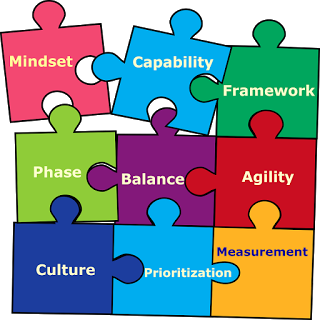 We are approaching the digital world with complexity, hyper-connectivity, and the highest level of education ever, and as a result, more people are competing in an increasingly competitive global arena. We also see much more innovation in more and more areas of the business landscapes as a result of an increasingly well-educated population across the globe. The purpose of Innovation Management is just so simple: If you work hard, have a good idea, and deliver to your customers, you will be rewarded. But it takes principle, strategy, discipline, and daily practices to flex your innovation muscle.
We are approaching the digital world with complexity, hyper-connectivity, and the highest level of education ever, and as a result, more people are competing in an increasingly competitive global arena. We also see much more innovation in more and more areas of the business landscapes as a result of an increasingly well-educated population across the globe. The purpose of Innovation Management is just so simple: If you work hard, have a good idea, and deliver to your customers, you will be rewarded. But it takes principle, strategy, discipline, and daily practices to flex your innovation muscle. Being innovative is more important than any specific innovation: Innovativeness is a way of thinking. We don’t really know the future of the industry or the environment, but we prepare ourselves to create it better and compete in it. While the change was often previously discrete, intermittent, and predictable, it is now constant and unpredictable, so often we need to change the way we change, it starts at the mindset level.
Looking at innovation from the perspective of developing business-wide innovation capabilities: Innovation has three “D” phases: Discovery of a problem or new idea; Design a prototype solution, and Delivery of a commercially astute outcome. That is the view to see innovation as a system, capable of delivering organization-wide capability.
Building an effective innovation framework to manage innovation in a structural way: The process to support the creation of sustainable and systematic innovation can be structuredInnovation Management system includes policies, structure, and program that innovation managers can use to drive innovation. You apply principles of approach and vary the resource and tool mix by the ever changing environment, you need to make sure, that your company has a steady flow of fresh ideas floating in and you have a methodological platform that allows you to do that.
 Businesses need to determine where best to focus their innovation activities: The “moment of Eureka” may be very exciting, but hanging on for the long term adoption and extended use phases could become quickly challenging and exhausting. So it pays to learn to view innovation matters realistically, and manage innovation phases and processes effectively.
Businesses need to determine where best to focus their innovation activities: The “moment of Eureka” may be very exciting, but hanging on for the long term adoption and extended use phases could become quickly challenging and exhausting. So it pays to learn to view innovation matters realistically, and manage innovation phases and processes effectively. Successful innovation is findly the bridge between “push” and “pull”: The minimum requirement for innovation is that the product, process, marketing method or organizational method must be new to the firm. “Pushing” only is not efficient to drive innovation, because idea creation scenario takes brainstorming, collaboration, knowledge absorbing and insight capture. Hence, it’s important for managers to pull all necessary resource and build a culture of creativity to harvest and make new ideas fruitful.
………
Innovation is the development of a new combination of available resources, in a way that solves problems of others in a more suitable way. From a business management perspective, shaping innovative mindsets, setting innovation principles, building innovation capabilities, and cultivating innovation agility are all crucial in making innovation management more practical than just serendipity.Follow us at: @Pearl_Zhu
Published on November 24, 2016 22:52
November 23, 2016
The New Book “Unpuzzling Innovation” Introduction: Chapter 1 Innovation Classification
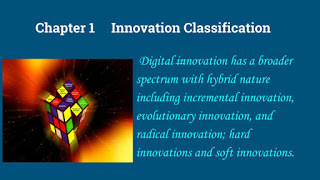 For many, innovation is serendipity; from others, it is a buzz word. It has many definitions. There is a vast terminology (types of innovation) in what some researchers call incremental (improvement, continuous, modular, components, etc.) and others call radical (breakthrough, disruptive, system, paradigmatic) innovation. For a business, innovation is “anything that is new to you.” The innovation classification is based on the position of the concept in the evolution tree. The classification is not based on the required investment, or on the potential market, but on its evolution abilities.
For many, innovation is serendipity; from others, it is a buzz word. It has many definitions. There is a vast terminology (types of innovation) in what some researchers call incremental (improvement, continuous, modular, components, etc.) and others call radical (breakthrough, disruptive, system, paradigmatic) innovation. For a business, innovation is “anything that is new to you.” The innovation classification is based on the position of the concept in the evolution tree. The classification is not based on the required investment, or on the potential market, but on its evolution abilities.Breakthrough innovation: Breakthrough innovation is better with greater ROI but with much greater risk. You need new technology, new processes, new customers, or even a new business model. All that makes them very risky, but on the other hand, you will get very great chances and opportunities for new product lines, platforms., etc. Research identifies the projects that ultimately break new ground frequently are fraught with uncertainty on many dimensions: technical, market, resource and organizational uncertainties abound. This requires them to be managed with fine-tuned processes to deal with uncertainty, but not stomp it out immediately. Breakthrough innovation is a radical new approach that leaves competitions behind in some way, it is disruptive and will change your organization in many fields.
Incremental Innovation: Innovation is in the eye of the beholder -customer. The only test for whether it is or is not an innovation is whether it makes any difference to a dimension that is valued by whoever has a stake in your offering. An incremental improvement of a product that allows the company increase sales, revenue, profit margins, market share, etc, is innovation. Adding value is the characteristics of an innovation. You cannot “disrupt” without incremental innovation being part of the process. Incremental innovation has become the value that the customer expects you to provide if you are to remain a sustainable supporting innovation, the unexpected disruption that can re-structure the competitive landscape.
 Business Model innovation: A business model is a multi-level, zoomable schema of how a business or an organization creates, delivers, and captures value for stakeholders: Customers, businesses, investors, or society. A business model is “why this business works.” If you can’t answer that in a few words, you probably don’t have a viable business. The business model defines customers, needs and solutions as well as competitive advantage. Ideally, a business balances its activities and resources in such a way, that it can be successful at both creating new forms of value and delivering and capturing from its existing forms. The starting point of business model innovation reflects one’s state of mind, so when you begin to design the model, you have to, as a business leader be very clear what you are and how you want to approach the markets. The mindset, vision, competency, capability, culture, and marketing opportunity are all great starting point for business model innovation.
Business Model innovation: A business model is a multi-level, zoomable schema of how a business or an organization creates, delivers, and captures value for stakeholders: Customers, businesses, investors, or society. A business model is “why this business works.” If you can’t answer that in a few words, you probably don’t have a viable business. The business model defines customers, needs and solutions as well as competitive advantage. Ideally, a business balances its activities and resources in such a way, that it can be successful at both creating new forms of value and delivering and capturing from its existing forms. The starting point of business model innovation reflects one’s state of mind, so when you begin to design the model, you have to, as a business leader be very clear what you are and how you want to approach the markets. The mindset, vision, competency, capability, culture, and marketing opportunity are all great starting point for business model innovation.Innovation comes in many flavors and there are many opportunities in an enterprise to do so. Incremental innovation is quantitative progress and radical innovation is transformational leapfrog. A healthy innovation portfolio needs to have both in order to reach innovation horizon with the optimal speed at the right time.Follow us at: @Pearl_Zhu
Published on November 23, 2016 23:11
Running a Future-Driven IT Organization to Catalyze Growth
 Organizations large or small are at the digital journey, corporate IT needs to shift from a back office support center to a future-driven growth engine. Because more often information is the lifeblood and technology is the disruptive force of digital transformation.
Organizations large or small are at the digital journey, corporate IT needs to shift from a back office support center to a future-driven growth engine. Because more often information is the lifeblood and technology is the disruptive force of digital transformation.Visionary and motivational IT leaders are in demand: Vision is to zoom into the future as if it were closer. Visionary IT leaders are business strategists who can leverage the latest technologies and navigate the organization towards the uncharted water or blurred digital territories. Nowadays, IT is the business, and IT management has a broadened scope, it often needs to work on or across the systems, not just in the system, to weave the digital hyperconnectivity through the entire digital ecosystem. To be an effective and motivational leaders, IT leaders needs to set a clear vision that shows a direction which sets in clarity. Setting a vision that isn't high enough doesn't challenge the organization to excel and unleash its full potential. On the other side, establishing a vision that is based on unrealistic expectations will either discount the value of even creating the vision or disenfranchise stakeholders. High motivation leads to high energetic and high-performance team. Low motivation leads to low commitment. To be a visionary leader, you needs to envision and share insight all the time; to be an effective leader and see positive results, you must invest, empower, and motivate yourself, if you plan to motivate others. You need to provide opportunities for employees’ growth, continue to develop your employees and ultimately drive the business’s long-term prosperity.
Future-driven IT is highly innovative and capable: Traditional IT organizations spends a significant amount of time to “fixing the symptoms and keep the bottom line.” The future-driven IT needs to spend a significant amount of time on strategy management and innovation. IT is no longer just the tangible hardware boxes which are heading into the commodity, the future of IT is more about the intangible information fabric with digital “SMAC” technologies interwoven into your organization. IT needs to build up the new set of core capabilities in transforming itself and business as a whole; the future-driven IT is an innovation solution provider to help organizations deliver the best-tailored products or solutions to its end customers. The future-driven IT focuses on building core business capabilities to catalyze growth and improve overall business competency. The future-driven IT can engage and align employees’ talent with the business's differentiated capabilities, and build digital IT workforces which are futuristic, flexible, and innovative, to achieve business goals with accountability at all levels.
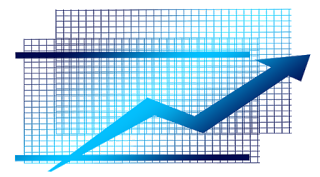 The future-driven IT organizations need to continually fine-tune a successful structure to improve customer-centricity: Compared to the traditional organizational structure with a rigid hierarchy, the digital blurs the functional, business, and even industrial territories. In the world that has been transformed by technology, many old and powerful hierarchies became ‘commoditized.” Traditional hierarchical lines will phase out and a collective of business partners will emerge working collaboratively to set and achieve organizational goals as well as strategy. The challenge for any business is to find a successful, often the hybrid (centralized vs. decentralized, physical vs. virtual) structure that helps to empower people, enforce iterative communication, and cross-functional collaboration to deliver better business results. The goal is to build an innovative of workplace and workforce, the limited hierarchy works best in a creative environment where the free flow of ideas and their prompt implementation is a key element of success.
The future-driven IT organizations need to continually fine-tune a successful structure to improve customer-centricity: Compared to the traditional organizational structure with a rigid hierarchy, the digital blurs the functional, business, and even industrial territories. In the world that has been transformed by technology, many old and powerful hierarchies became ‘commoditized.” Traditional hierarchical lines will phase out and a collective of business partners will emerge working collaboratively to set and achieve organizational goals as well as strategy. The challenge for any business is to find a successful, often the hybrid (centralized vs. decentralized, physical vs. virtual) structure that helps to empower people, enforce iterative communication, and cross-functional collaboration to deliver better business results. The goal is to build an innovative of workplace and workforce, the limited hierarchy works best in a creative environment where the free flow of ideas and their prompt implementation is a key element of success.The future-driven IT organizations step out of the traditional IT box, to understand the business and customers better via longer time frame. The challenge is having a harmonized vision about overall IT capabilities and maturities in an IT organization. CIOs need to be transformative leaders to advocate for their organization, to bridge the gaps, to shape the culture of innovation, and to build the momentum for the non-stoppable digital paradigm shift.
Follow us at: @Pearl_Zhu
Published on November 23, 2016 23:06
November 22, 2016
The Monthly Foresight: The Hybrid Nature of Digital Organization Nov. 2016
The organization with the hybrid nature is alive, holistic, vibrant, energetic, responsive, fluid, innovative and resilient.
 We live in the world with both “old” and “new,” embracing digital is inevitable as that it is now part of reality. The latest enterprise digital computing technologies enable seamless virtual platforms, enhance physical organizational structures, empower workforce sharing the thoughts and ideas, engage customers and partners to voice concerns and feedbacks, and encourage the broader conversation and interaction within its business ecosystem. Digital organization has a hybrid nature with flexibility, agility and innovativeness.
We live in the world with both “old” and “new,” embracing digital is inevitable as that it is now part of reality. The latest enterprise digital computing technologies enable seamless virtual platforms, enhance physical organizational structures, empower workforce sharing the thoughts and ideas, engage customers and partners to voice concerns and feedbacks, and encourage the broader conversation and interaction within its business ecosystem. Digital organization has a hybrid nature with flexibility, agility and innovativeness.
Renovate a Hybrid IT and Digital Organization The pervasive digitalization or IT consumerization requires the balance of “old experiences” and “new ways to do things,” the learning and doing.” The reach and range flexibility that now exists removes barriers that have existed in the past. The emergence of potential opportunities for exploiting digitization is likely to follow a nonlinear pattern or exponential speed, as the pervasiveness of an organization’s digitization journey increases.
Digital Shift: From a Mechanical to Sociological System From philosophical perspective, all things serve a purpose. We may not understand the purpose, but all things serve one. Modern organization has transcendent business purpose. Humans demand to be served, so they create mechanistic and sociological systems to serve them. Enterprises demand to be served, so they create positions of employment and mechanistic systems to serve them. These systems have a purpose for which they act to fill the purpose. The digital paradigm that is emerging is the sociological organization that is alive, holistic, vibrant, energetic, responsive, fluid, innovative and resilient?
Hybrid Minds? Hybrid Thinking is a set of interdisciplinary and integrative thinking processes we will need to solve many of today’s complex problems which require strategic consideration, systems intelligence, innovative approaches, cross-cultural and cross-generational perspectives.
Hybrid Innovation Innovation is a management discipline, just like many key elements in businesses today, such as leadership, culture, process, or technology, etc, HYBRID is the digital fit style for managing innovation. From portfolio management point of view, companies need both incremental product/service innovations to thrive, but also desire large, disruptive innovations for a quantum leap. Managing innovation requires leaders, either formal or informal, to shepherd an idea through several phases of development, knowing when to move forward and when to return to an earlier phase. But more specifically, what is hybrid innovation and how to manage it effectively?
 Three Aspects in Running a Hybrid IT and Digital Organization In order to lead change and drive digital transformation, IT should combine the old way to do things, and the new way to explore, the next practices and the best practices, take the balance of traditional hierarchy and flatter structure; keep the lights on,” and “doing more with innovation.” Either from management, technology or talent perspective, Is HYBRID the right way to move forward with the right speed?
Three Aspects in Running a Hybrid IT and Digital Organization In order to lead change and drive digital transformation, IT should combine the old way to do things, and the new way to explore, the next practices and the best practices, take the balance of traditional hierarchy and flatter structure; keep the lights on,” and “doing more with innovation.” Either from management, technology or talent perspective, Is HYBRID the right way to move forward with the right speed?
The blog is a dynamic book flowing with your thought; growing through your dedication; sharing your knowledge; conveying your wisdom, and making influence through touching the hearts and connecting the minds across the globe. The “Future of CIO” Blog has reached 1.6 million page views with about #3300 blog posting. Among 59+ different categories of leadership, management, strategy, digitalization, change/talent, etc. Blogging is not about writing, but about thinking and innovating the new ideas; it’s not just about WHAT to say, but about WHY to say, and HOW to say it. It reflects the color and shade of your thought patterns, and it indicates the peaks and curves of your thinking waves. Unlike pure entertainment, quality and professional content takes time for digesting, contemplation and engaging, and therefore, it takes the time to attract the "hungry minds" and the "deep souls." It’s the journey to amplify diverse voices and deepen digital footprints, and it's the way to harness your innovative spirit.
Follow us at: @Pearl_Zhu
 We live in the world with both “old” and “new,” embracing digital is inevitable as that it is now part of reality. The latest enterprise digital computing technologies enable seamless virtual platforms, enhance physical organizational structures, empower workforce sharing the thoughts and ideas, engage customers and partners to voice concerns and feedbacks, and encourage the broader conversation and interaction within its business ecosystem. Digital organization has a hybrid nature with flexibility, agility and innovativeness.
We live in the world with both “old” and “new,” embracing digital is inevitable as that it is now part of reality. The latest enterprise digital computing technologies enable seamless virtual platforms, enhance physical organizational structures, empower workforce sharing the thoughts and ideas, engage customers and partners to voice concerns and feedbacks, and encourage the broader conversation and interaction within its business ecosystem. Digital organization has a hybrid nature with flexibility, agility and innovativeness.Renovate a Hybrid IT and Digital Organization The pervasive digitalization or IT consumerization requires the balance of “old experiences” and “new ways to do things,” the learning and doing.” The reach and range flexibility that now exists removes barriers that have existed in the past. The emergence of potential opportunities for exploiting digitization is likely to follow a nonlinear pattern or exponential speed, as the pervasiveness of an organization’s digitization journey increases.
Digital Shift: From a Mechanical to Sociological System From philosophical perspective, all things serve a purpose. We may not understand the purpose, but all things serve one. Modern organization has transcendent business purpose. Humans demand to be served, so they create mechanistic and sociological systems to serve them. Enterprises demand to be served, so they create positions of employment and mechanistic systems to serve them. These systems have a purpose for which they act to fill the purpose. The digital paradigm that is emerging is the sociological organization that is alive, holistic, vibrant, energetic, responsive, fluid, innovative and resilient?
Hybrid Minds? Hybrid Thinking is a set of interdisciplinary and integrative thinking processes we will need to solve many of today’s complex problems which require strategic consideration, systems intelligence, innovative approaches, cross-cultural and cross-generational perspectives.
Hybrid Innovation Innovation is a management discipline, just like many key elements in businesses today, such as leadership, culture, process, or technology, etc, HYBRID is the digital fit style for managing innovation. From portfolio management point of view, companies need both incremental product/service innovations to thrive, but also desire large, disruptive innovations for a quantum leap. Managing innovation requires leaders, either formal or informal, to shepherd an idea through several phases of development, knowing when to move forward and when to return to an earlier phase. But more specifically, what is hybrid innovation and how to manage it effectively?
 Three Aspects in Running a Hybrid IT and Digital Organization In order to lead change and drive digital transformation, IT should combine the old way to do things, and the new way to explore, the next practices and the best practices, take the balance of traditional hierarchy and flatter structure; keep the lights on,” and “doing more with innovation.” Either from management, technology or talent perspective, Is HYBRID the right way to move forward with the right speed?
Three Aspects in Running a Hybrid IT and Digital Organization In order to lead change and drive digital transformation, IT should combine the old way to do things, and the new way to explore, the next practices and the best practices, take the balance of traditional hierarchy and flatter structure; keep the lights on,” and “doing more with innovation.” Either from management, technology or talent perspective, Is HYBRID the right way to move forward with the right speed?The blog is a dynamic book flowing with your thought; growing through your dedication; sharing your knowledge; conveying your wisdom, and making influence through touching the hearts and connecting the minds across the globe. The “Future of CIO” Blog has reached 1.6 million page views with about #3300 blog posting. Among 59+ different categories of leadership, management, strategy, digitalization, change/talent, etc. Blogging is not about writing, but about thinking and innovating the new ideas; it’s not just about WHAT to say, but about WHY to say, and HOW to say it. It reflects the color and shade of your thought patterns, and it indicates the peaks and curves of your thinking waves. Unlike pure entertainment, quality and professional content takes time for digesting, contemplation and engaging, and therefore, it takes the time to attract the "hungry minds" and the "deep souls." It’s the journey to amplify diverse voices and deepen digital footprints, and it's the way to harness your innovative spirit.
Follow us at: @Pearl_Zhu
Published on November 22, 2016 21:56
Three Aspects in Running Digital Ready IT
 Forward-looking organizations large and small are on the journey of digital transformation. The word "transformation" in itself means change and change for the better, with new ways and methods of doing things, new structures, new relationships etc. There are changes in two shapes in IT digital transformation: One is internal where IT transforms itself to become faster and more effective, and the second is where IT helps transform or change the entire business in line with new strategic imperatives. Here are three aspects in running digital ready IT organization:
Forward-looking organizations large and small are on the journey of digital transformation. The word "transformation" in itself means change and change for the better, with new ways and methods of doing things, new structures, new relationships etc. There are changes in two shapes in IT digital transformation: One is internal where IT transforms itself to become faster and more effective, and the second is where IT helps transform or change the entire business in line with new strategic imperatives. Here are three aspects in running digital ready IT organization: Digital ready mindset: IT is shifting from inside-out operation driven to outside-in customer oriented. Running an outside-in IT starts from mind shift of the IT leaders, the CIO plays a digital visionary and change agent role in business transformation via systematic thinking and well thought-out planning. It is important for both IT leaders and digital professionals to cultivate a healthy thinking habit in making sound judgments and effective decisions on the daily basis, equip digital ready mindset to think broadly, think profoundly, think critically, think creatively, and think holistically. From IT talent management and performance management perspective, IT talent gap is the reality, traditional performance management becomes the very bottleneck to truly understand the authenticity and potential of talented professionals, because often “Who they are,” not just depend on what they do, or what they say, but about what they think, and how they think. To assess digital mindset, the breakdown of assessment types about thinking performance includes innate thinking capabilities and styles, cognitive skills and decision-making biases; behavioral styles and patterns; motivational drivers and passions. Digital ready IT can unleash the business potential via aligning employees performance and potential with the business’s strategy and vision to build win-win advantage and business competency.
Customer-centric IT management: Digital is the age of people. The digital revolution means that channels to customers. IT has both internal business customers and end customers. IT plays a crucial role in optimizing and digitizing every touch point of customer experience and improving overall customer satisfaction. Embracing digital is inevitable as that is now part of the business venture. Customer Centricity is built upon rigorous business’s capabilities and processes in which IT is the “super glue.” The strategy mapping allow you to first understand your customers and what they value, and then identifies how to best characterize that value and manage a healthy IT portfolio to achieve it. When there is no willingness to serve users and on the other way round, no appetite from users to involve IT, the gaps get bigger and dangerous behaviors may get introduced.
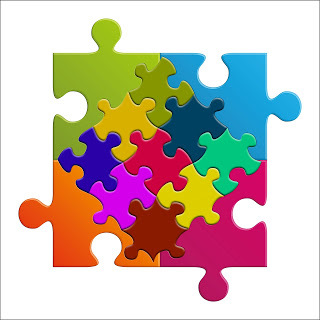 Doing more with innovation, and doing less to achieve more: IT Transformation focuses on goals of innovation. A transformation needs to work cross boxes instead within the box. IT transformation means rationalizing current IT department, and planning to partner with the business to provide tailored service and solutions in new ways. IT transformation means doing more with innovation, transparency, and discipline. It is important to create an "innovation culture" involves the good alignment of people, process, and technology, otherwise, it won’t sustain. Innovation needs to be well embedded into the business culture, and process mechanism in order to run an IT as an innovation engine of the organization. If you can innovate across the business, regardless of which function you are involved in, be it IT, HR, finance etc, and then you can surely change the shape of what you deliver, not just how it's delivered. Dynamic and changing digital organizations cannot operate with static, unchanging people. A digital ready IT can empower employees to apply technologies to perform their work in a way that benefits the enterprise.
Doing more with innovation, and doing less to achieve more: IT Transformation focuses on goals of innovation. A transformation needs to work cross boxes instead within the box. IT transformation means rationalizing current IT department, and planning to partner with the business to provide tailored service and solutions in new ways. IT transformation means doing more with innovation, transparency, and discipline. It is important to create an "innovation culture" involves the good alignment of people, process, and technology, otherwise, it won’t sustain. Innovation needs to be well embedded into the business culture, and process mechanism in order to run an IT as an innovation engine of the organization. If you can innovate across the business, regardless of which function you are involved in, be it IT, HR, finance etc, and then you can surely change the shape of what you deliver, not just how it's delivered. Dynamic and changing digital organizations cannot operate with static, unchanging people. A digital ready IT can empower employees to apply technologies to perform their work in a way that benefits the enterprise.Digital ready IT means mindset ready, skill ready, people ready and culture ready. It is about accelerating speed to adapt to changes, being learning agile to enhancing IT capacity to create, being innovative to commercialize the value of new ideas to drive growth and being people centric to engage employees and improve customer satisfaction, and ultimately achieving high-performance business result.
Follow us at: @Pearl_Zhu
Published on November 22, 2016 21:45
The New Book "Unpuzzling Innovation" Introduction: Mastering Innovation Management in a Structural Way
Innovation is the process which can be classified scientifically and managed dynamically.
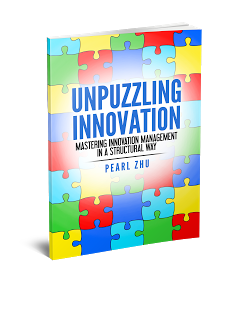 Digital is the age of innovation. And innovation is what leads to differentiation. There are many ways to differentiate and, therefore, there are many ways to pursue innovation. Talking of innovation is not new nowadays, everybody, every organization now is talking about innovation. It's been at or near the top of the business or economics agenda for a long time. However, there’re a lot of confusions about innovation and there is no magic sauce to guarantee its success. One of the good definitions of innovation is: "to transform the novel ideas into commercial success.” In essence, innovation is, "intentional novelty bringing sustainable benefit."
Digital is the age of innovation. And innovation is what leads to differentiation. There are many ways to differentiate and, therefore, there are many ways to pursue innovation. Talking of innovation is not new nowadays, everybody, every organization now is talking about innovation. It's been at or near the top of the business or economics agenda for a long time. However, there’re a lot of confusions about innovation and there is no magic sauce to guarantee its success. One of the good definitions of innovation is: "to transform the novel ideas into commercial success.” In essence, innovation is, "intentional novelty bringing sustainable benefit."
The purpose of the book “Unpuzzling Innovation - Mastering Innovation Management in a Structural Way“ is to demystify innovation puzzle in a structural way. Innovation is the process which can be classified scientifically and managed dynamically. Innovation is neither serendipity nor status quo, it needs to break some outdated rules, builds digital principles, and takes a systematic approach with robust, but not overly rigid processes to implement it. Digital innovators are the “whole-brainers” who present leadership skills and multidimensional intelligence, to mastering the “art of possible.” Creativity is simply about connecting the dots, the difference between innovation and creativity is implementation. It’s important to develop a set of best/next practices to manage digital innovation continuum effectively. It’s also critical to understand the paradox of innovation and strike the right balance between ideation and execution part of the innovation process and management. Innovation journey is thorny, be cautious about gaps and pitfalls on the way, to improve innovation success rate and measure it in the right way.
Chapter 1 Innovation classification: Digital innovation has a broader spectrum with hybrid nature including incremental innovation, evolutionary innovation, and radical innovation; hard innovations such as products/service innovation, business model or process innovation, and soft innovations such as leadership innovation, communication innovation, and culture innovation. The gap between incremental and radical innovation is huge both in terms of outcomes if successful and on how to approach.
Chapter 2 Innovation principles: Digital brings both unprecedented opportunities and risks to the businesses today. Every innovation-the creative pursuit has the risk in it. You're accepting risk for potential reward. Therefore, it is important to set principles for managing innovation and handling risk in a structural way. The principles and guidelines help to further frame processes, measures, and control.
Chapter 3 Digital innovators: Creativity is a high level of thinking and intelligence. Intelligence is the quick and clear perception of any situation, plus ability to adjust to any circumstances. It is contextual and multidimensional. Digital innovators present leadership skills, master at creative communication, understand what is wrong with the status quo, have the good sense and sound judgment to attract and surround themselves with the right people, and work collaboratively to do more with innovation.
Chapter 4 Connecting innovation dots: Creativity is infused with an inner cohesion and comes from a vision of uniqueness. Creativity is simply about connecting the dots. Creativity needs a problem, and a creative person needs a purpose. The difference between innovation and creativity is implementation. Innovation is to reinvent business, but not to reinvent the wheels. Innovation is about reinventing the business direction or purpose, which defines strategy, profitability and relevance at any given time. Innovation allows one to stand out and above the rest.
Chapter 5 Digital innovation next practices: Digital innovation has a broader spectrum with hybrid nature, it is the incremental improvement- radical innovation continuum. It is hard to think of any innovation as not a hybrid, a combination of something old with something new or a number of new things. Probably, the more hybrid, the more familiar things are combined, the less likely is any disruption, although all innovations are disruptive of something or some behavior to some degree. The innovation leaders need to master at managing complexity and dynamic of innovation portfolio more effectively.
Chapter 6 Innovation paradox: Innovation is to transform the novel ideas and achieve their business value. Innovation is not just about ideas or exchanging ideas, based on most of the innovation models, idea creation is only one step of the innovation process. Therefore, in a basic view, innovation is a process and every process needs to be managed. The paradox is that all creative activities are subversive in questioning the status quo. Setting rules and goals for creativity goes against the very nature of creativity and thus inventiveness and innovation. It’s critical to strike the right balance between ideation and execution part of the innovation process and management.
Chapter 7 Innovation gaps and pitfalls: Innovation fails because, there are too many disconnects that occur between the birth of a vision/concept and the process of turning it into a reality. Innovation fails because businesses lack cognitive ability to think alternatives. The reasons why failure occurs vary widely. It is no wonder why many leaders are reluctant to act on bold ideas with good business potential due to the high likelihood of failure.
 Chapter 8 Innovation measurement: The impact of innovations on enterprise performance ranges from effects on turnover and market share to changes in productivity and efficiency. The problem is often that the initiative is not well defined. Without well-defined goals, you won’t have the effective plan and enough time to generate results. So, it is difficult to measure the impact without taking the time to generate impact.
Chapter 8 Innovation measurement: The impact of innovations on enterprise performance ranges from effects on turnover and market share to changes in productivity and efficiency. The problem is often that the initiative is not well defined. Without well-defined goals, you won’t have the effective plan and enough time to generate results. So, it is difficult to measure the impact without taking the time to generate impact.
“Innovation is the specific instrument of entrepreneurship...the act that endows resources with a new capacity to create wealth.” ― Peter F. Drucker
"Unpuzzling Innovation" Book Slideshare Presentation Follow us at: @Pearl_Zhu
 Digital is the age of innovation. And innovation is what leads to differentiation. There are many ways to differentiate and, therefore, there are many ways to pursue innovation. Talking of innovation is not new nowadays, everybody, every organization now is talking about innovation. It's been at or near the top of the business or economics agenda for a long time. However, there’re a lot of confusions about innovation and there is no magic sauce to guarantee its success. One of the good definitions of innovation is: "to transform the novel ideas into commercial success.” In essence, innovation is, "intentional novelty bringing sustainable benefit."
Digital is the age of innovation. And innovation is what leads to differentiation. There are many ways to differentiate and, therefore, there are many ways to pursue innovation. Talking of innovation is not new nowadays, everybody, every organization now is talking about innovation. It's been at or near the top of the business or economics agenda for a long time. However, there’re a lot of confusions about innovation and there is no magic sauce to guarantee its success. One of the good definitions of innovation is: "to transform the novel ideas into commercial success.” In essence, innovation is, "intentional novelty bringing sustainable benefit." The purpose of the book “Unpuzzling Innovation - Mastering Innovation Management in a Structural Way“ is to demystify innovation puzzle in a structural way. Innovation is the process which can be classified scientifically and managed dynamically. Innovation is neither serendipity nor status quo, it needs to break some outdated rules, builds digital principles, and takes a systematic approach with robust, but not overly rigid processes to implement it. Digital innovators are the “whole-brainers” who present leadership skills and multidimensional intelligence, to mastering the “art of possible.” Creativity is simply about connecting the dots, the difference between innovation and creativity is implementation. It’s important to develop a set of best/next practices to manage digital innovation continuum effectively. It’s also critical to understand the paradox of innovation and strike the right balance between ideation and execution part of the innovation process and management. Innovation journey is thorny, be cautious about gaps and pitfalls on the way, to improve innovation success rate and measure it in the right way.
Chapter 1 Innovation classification: Digital innovation has a broader spectrum with hybrid nature including incremental innovation, evolutionary innovation, and radical innovation; hard innovations such as products/service innovation, business model or process innovation, and soft innovations such as leadership innovation, communication innovation, and culture innovation. The gap between incremental and radical innovation is huge both in terms of outcomes if successful and on how to approach.
Chapter 2 Innovation principles: Digital brings both unprecedented opportunities and risks to the businesses today. Every innovation-the creative pursuit has the risk in it. You're accepting risk for potential reward. Therefore, it is important to set principles for managing innovation and handling risk in a structural way. The principles and guidelines help to further frame processes, measures, and control.
Chapter 3 Digital innovators: Creativity is a high level of thinking and intelligence. Intelligence is the quick and clear perception of any situation, plus ability to adjust to any circumstances. It is contextual and multidimensional. Digital innovators present leadership skills, master at creative communication, understand what is wrong with the status quo, have the good sense and sound judgment to attract and surround themselves with the right people, and work collaboratively to do more with innovation.
Chapter 4 Connecting innovation dots: Creativity is infused with an inner cohesion and comes from a vision of uniqueness. Creativity is simply about connecting the dots. Creativity needs a problem, and a creative person needs a purpose. The difference between innovation and creativity is implementation. Innovation is to reinvent business, but not to reinvent the wheels. Innovation is about reinventing the business direction or purpose, which defines strategy, profitability and relevance at any given time. Innovation allows one to stand out and above the rest.
Chapter 5 Digital innovation next practices: Digital innovation has a broader spectrum with hybrid nature, it is the incremental improvement- radical innovation continuum. It is hard to think of any innovation as not a hybrid, a combination of something old with something new or a number of new things. Probably, the more hybrid, the more familiar things are combined, the less likely is any disruption, although all innovations are disruptive of something or some behavior to some degree. The innovation leaders need to master at managing complexity and dynamic of innovation portfolio more effectively.
Chapter 6 Innovation paradox: Innovation is to transform the novel ideas and achieve their business value. Innovation is not just about ideas or exchanging ideas, based on most of the innovation models, idea creation is only one step of the innovation process. Therefore, in a basic view, innovation is a process and every process needs to be managed. The paradox is that all creative activities are subversive in questioning the status quo. Setting rules and goals for creativity goes against the very nature of creativity and thus inventiveness and innovation. It’s critical to strike the right balance between ideation and execution part of the innovation process and management.
Chapter 7 Innovation gaps and pitfalls: Innovation fails because, there are too many disconnects that occur between the birth of a vision/concept and the process of turning it into a reality. Innovation fails because businesses lack cognitive ability to think alternatives. The reasons why failure occurs vary widely. It is no wonder why many leaders are reluctant to act on bold ideas with good business potential due to the high likelihood of failure.
 Chapter 8 Innovation measurement: The impact of innovations on enterprise performance ranges from effects on turnover and market share to changes in productivity and efficiency. The problem is often that the initiative is not well defined. Without well-defined goals, you won’t have the effective plan and enough time to generate results. So, it is difficult to measure the impact without taking the time to generate impact.
Chapter 8 Innovation measurement: The impact of innovations on enterprise performance ranges from effects on turnover and market share to changes in productivity and efficiency. The problem is often that the initiative is not well defined. Without well-defined goals, you won’t have the effective plan and enough time to generate results. So, it is difficult to measure the impact without taking the time to generate impact. “Innovation is the specific instrument of entrepreneurship...the act that endows resources with a new capacity to create wealth.” ― Peter F. Drucker
"Unpuzzling Innovation" Book Slideshare Presentation Follow us at: @Pearl_Zhu
Published on November 22, 2016 13:31
November 21, 2016
The Monthly “Thinkingaire” Book Tuning “Out-of-the-Box” Thinking and Thinkers Nov. 2016
 We have moved into the new digital age when information is abundant and where creativity becomes a baseline competence. The race of human against the machine is ongoing. The knowledge life cycle is significantly shortened, and the pace of information technology is so rapid that no one can rest on a static mindset, past accomplishments, or the wishful thought that everything is perfect the way it is. Indeed, the mindset is far more important than talent. Out-of-the-Box thinking is the metaphor of thinking creatively. Here are a set of blogs to brainstorm out-of-the-box thinking and thinkers.
We have moved into the new digital age when information is abundant and where creativity becomes a baseline competence. The race of human against the machine is ongoing. The knowledge life cycle is significantly shortened, and the pace of information technology is so rapid that no one can rest on a static mindset, past accomplishments, or the wishful thought that everything is perfect the way it is. Indeed, the mindset is far more important than talent. Out-of-the-Box thinking is the metaphor of thinking creatively. Here are a set of blogs to brainstorm out-of-the-box thinking and thinkers.“Out-of-the-Box” Thinking and ThinkersThe New Book “Thinkingare” Introduction Chapter 1 “Out of Box” Thinking Minds Out-of-the-Box thinking implies a certain level of creativity or unconventional problem solving. “The box” is the mental construct made up of personal or environmental components that one operates within. Most often, the box is your safety net and your comfort zone. So thinking outside “the box” means doing something outside of the confines of the construct. It’s easy for things in the box to turn stale and stagnant, great things don’t happen inside your comfort zone or in a box. Fundamentally, the “box” is also the set of “rules” that you are abiding by at any moment in time, by breaking down those old rules, your mind is set free to create the new ideas that arising from identifying and challenging assumptions and then generating more possibilities.
Thinking Out-of-the-Box, What is your Box Though? Every mind has a certain box, some smaller, some bigger; the box starts set-up at a very early age, by your surroundings, the education you received, the people you interacted with and the standards by which you lived. The "boxes" are the walls in your mind. Walls in your mind are constructed by society's conditioning (rules imposed by parents, teachers, leaders, media, books, etc). When you allow information into being accepted as absolute "truth" without first using critical thinking, it inhibits your ability to also think creatively. So in order to think "out of the box," you have to clarify what's inside your box, though?
Three Questions to Assess a Person’s “Out-of-Box” Thinking Ability Every mind has a certain box, some smaller, some bigger. The box starts set-up at a very early age, by your surroundings, the media you followed, the books you read, the education you received, the people you interacted with and the standards by which you lived. The "boxes" are the walls in your mind. Walls in your mind are constructed by the society's conditioning and rules imposed by influencers. However, the box keeps changing, in today's competitive environment, what was outside the box yesterday, may not be such today. Our thinking has to continuously evolve, adapt, and prepare for change. Which questions should you ask to assess a person’s “Out-of-box” thinking ability?
Are Visionary CIOs Often Outliers? Modern CIOs have multiple personas, they have to wear different hats to fit the roles situationally in order to lead effectively. Technology is complex, business is complex, and people are complex. Due to increasing changes in the digital dynamic environment, The CIOs needs to be a dynamic person with vision, open, growth and complexity mindset- with high ability to envision the digital trends, manage innovations, communicating to suite situations so as to craft strategies and make things happen. Visionary CIOs are in demand, and, are visionary Who are they, and what can they do to drive digital transformation of the business?
 Is there anything as too much out-of-the-box thinking? Fundamentally, the "box" is the set of "rules" you are abiding by at any moment in time, by a breakdown of old rules, your mind sets free to create the new ideas, usually, comes from identifying and challenging assumptions and then generating more possibilities. However, without box (rules), can you generate more useful and achievable ideas? Is there anything as too much out of the box thinking?
Is there anything as too much out-of-the-box thinking? Fundamentally, the "box" is the set of "rules" you are abiding by at any moment in time, by a breakdown of old rules, your mind sets free to create the new ideas, usually, comes from identifying and challenging assumptions and then generating more possibilities. However, without box (rules), can you generate more useful and achievable ideas? Is there anything as too much out of the box thinking?The “Future of CIO” Blog has reached 1.6 million page views with about 3300+ blog posting in 59+ different categories of leadership, management, strategy, digitalization, change/talent, etc. The content richness is not for its own sake, but to convey the vision and share the wisdom. Blogging is not about writing, but about thinking; it’s not just about WHAT to say, but about WHY to say, and HOW to say it. It reflects the color and shade of your thought patterns, and it indicates the peaks and curves of your thinking waves. Unlike pure entertainment, quality and professional content takes time for digesting, contemplation and engaging, and therefore, it takes time to attract the "hungry minds" and the "deep souls." It’s the journey to amplify your voice, deepen your digital footprints, and match your way for human progression.
Follow us at: @Pearl_Zhu
Published on November 21, 2016 22:56



